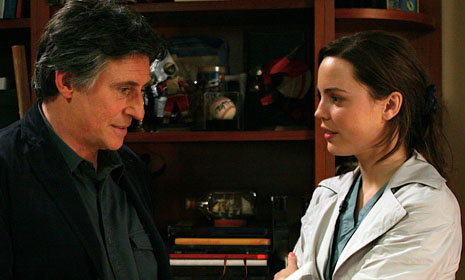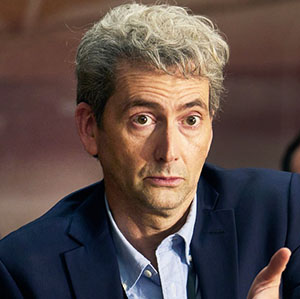In Treatment
Series 1 | Warner | $89.95
AFTER watching In Treatment I’ve concluded that one of the unhealthiest relationships of all is the one between screenwriter and audience.
Screenwriters persuade us to adore characters we should hate and make us see ourselves in the most demented scenarios. By season three of The Sopranos I had developed an unforgivable crush on Tony Soprano – murdering, cheating bully that he is – not to mention an insatiable appetite for cannoli. I single out Tony because his complexity and my empathy were achieved through psychoanalysis. What better way to build characters and then brutally rip them apart than by sticking them in therapy?
HBO’s most recent gem, In Treatment, is The Sopranos without the mafia and the long title sequence. The series takes place almost entirely inside a psychologist’s home office, each short episode (twenty-five minutes) being one therapy session from start to finish. As in The Sopranos, the shrink in In Treatment is dealing with his own problems: a troubled marriage, uncertain patient–therapist boundaries and a crippling tendency to analyse, rather than relate to, the people he loves. Gabriel Byrne’s performance as Dr Paul Weston is so honest and complex that it leaves you stripped of pretences, attuned to insecurities and reeling at the pitfalls of the human condition. By the end of the series I almost felt as though I was right there on his couch, not flopped out on mine.
Byrne could not have sustained forty-three episodes in one room, though, without a superbly crafted screenplay. The most important rule of screenwriting is to hold back, to resist the temptation to explain the action. With close-up characters, the complexity resides in what they don’t tell us, both the secrets and the self-denial. This makes the therapy room a convenient way into the narratives people construct around themselves, including the subtle mistruths and the interpersonal boundaries that we all negotiate. As the audience we unpick each character, analysing their motives exactly as a therapist might. But in fact we, the audience, become the patient, manoeuvred wherever the writer can push us.
And then there is the problem of addiction. The short episodes of In Treatment mean that you can eat through them like snacks – two, three, four a night. Soon you are psychoanalysing everything on screen and off. By about the thirtieth episode you are asking the same question as Paul’s patients: “Is this actually doing me any good?” And like his patients you keep going back anyway.
I have heard it said that the series gets to the heart of some very real issues in the practice of psychology, but I’m not sure whether that matters. The premise is that Paul is probably not a very good therapist anyway. His patients are a young female anaesthesiologist with a classic case of transference (played by Melissa George), a military pilot needing a psychological reference (Blair Underwood), a teenage gymnast (Mia Wasikowska) and a fiery couple deciding whether to terminate a pregnancy (Embeth Davidtz and Josh Charles). They turn up consecutively at the same time every week. On the fifth night, Paul undergoes therapy of sorts with his former mentor, Gina (Dianne Wiest), who puts him through his paces and matches Byrne with her own exceptional screen performance. The two are intensely combative, undoing each other’s strategies and picking to pieces the show’s narrative along the way. Gina tells Paul that his style with the anaesthesiologist, Laura, is “impulsive, unorganised and… very problematic,” even though we have witnessed his restraint earlier in the “week.” In return, Paul calls Gina “The Spider,” describing her suggestions as “corrosive attacks” and “analytic castration.”
All of the stories have their moments, but the best involve Sophie, the teenage gymnast, who may or may not have intentionally cycled into a car. Her treatment brings out a medical dictionary array of teenage neuroses, including suicidal tendencies, sexual abuse and anorexia, but none of these really explain what Sophie is about. She oscillates between intelligence and impertinence and spouts naff teenage clichés like “free your mind and the rest will follow.” She treats her mother like shit and idolises her photographer father who is mostly absent from her life except through telepathic connection. The character is both a serious head-case and a very normal kid.
At times, the problems that these characters experience border on cliché, but the writing digs deep enough for the obvious to become believable. It makes you see how “casebook” problems come about and demonstrates that people are generally more readable than we would like to think we are. The petty dramas mostly explore how what’s “in the mind” can harm us and those around us and how not every relationship can be resolved. A nice moment comes when Alex, the fighter pilot, concludes that repressing some things might be an easier path to happiness than the self-indulgence of therapy.
The series does have some flaws. In particular, the blame game becomes a little overbearing (blaming the therapist, blaming Gina, blaming parents) and there is a stagey feel at times (mostly with Laura’s story). Everyone is resisting Paul’s pet theory of the day and no one ever says, “Yes, I think you have a point there. I will work on that.” I got a little bored with the line “It’s got nothing to do with my father” and I cheered when Paul’s wife Kate (Michelle Forbes) told him to shove his stupid theories. But this is such a brave adventure in screenwriting that when the action does occasionally venture outside of Paul’s room you feel as though it is getting too close to normal television. In the end, that scruffy old velvet couch is just too compelling to resist. •




